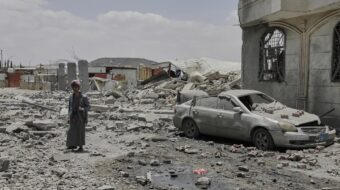Translated by Nikita Shah
(l’Humanite) At the height of the international crisis, the Canton trade fair [1], the traditional barometer of Chinese foreign trade, has this year reflected China’s important new economic trends. For the first time in its long existence (105 years), Chinese buyers and entrepreneurs (the latter initially turned towards exports) have been authorized to meet. This is effectively a measure taken to compensate for the fall in Chinese exports and to develop the domestic market, one of the key trends defined by the governmental recovery plan adopted last autumn to come to terms with the global financial crisis.
A sign of difficult times, the total number of foreign participants has dropped to 5.2%, and it is above all American buyers (15%) and European buyers (30%) who have failed to show up. An African presence was also on the increase, representing 10% of foreign clientele, but the trade fair also confirmed regional Asiatic integration as a significant factor. The fall in exports to the USA and Europe has increased in the last few months (30% on average since December), bringing about the closure of several tens of thousands of factories, leaving unemployed millions of precarious workers from the countryside. At the same time, exports towards ASEAN countries [2] have increased by 4.5%. The development of trading ties with Vietnam is probably the most convincing example. In 2008, they reached $3.36 million, that is, an increase of 37%. In 2007, they had already made a leap of 45%.
On the other hand, however, Asian imports toward China benefit from the upturn of growth which has been observed there in the past few weeks, derived from public spending and credit. In the first quarter, the Chinese economy increased by 6.1% according to official statistics. Numerous early indicators confirm this improvement: the production of intermediate goods and investment in construction spread (+70% in one year in March 2009 with public infrastructure plans), hence a reboot of GDP which had stagnated in the fourth quarter of 2008. The amount of electricity used in March increased by 13.8% in Shanghai and by 26% in the Guangdong province.
Certain observers think that strictly speaking, there is not a crisis in China, but rather that there has been a slowdown in economic activity. ‘The role of the state has been decisive. Two months after the implementation of the €460 million recovery plan, its effects have been seen. Public businesses and cooperatives have had access to credit, and investments in big infrastructure schemes are bearing their fruits’, reckons a French expatriate from Shanghai.
To insure that its gamble pays off, Peking knows that it must deal with the most urgent matters first – social exigency – all the while leading to an in-depth transformation of the country to correct the gigantic imbalances due to the growth model of past decades. In ensuring in this recovery plan a budget of €40 million for health, and €15 million for education, the government hopes to restore the confidence of Chinese people and to tap their savings towards consumption. A project additionally accompanied by, for rural workers, subsidies on purchases of household electrical appliances. Today, the Chinese government speaks with caution of its revival. Will it last? In this case, it could extend to the rest of Asia considering commercial ties with China. In any case, the question to be posed would be to know if it will be enough to get the world economy started again.
[1] It took place during a three-week period ending May 7th.
[2] ASEAN – The Association of Southeast Asian Nations









